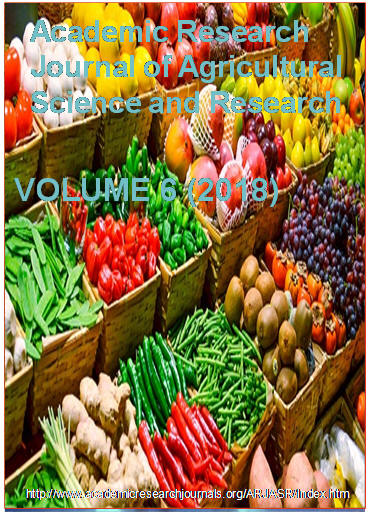| ARJASR |
Academic Research Journal of
Agricultural Science and Research |
||||||||||||||||||||||
|
Academic Research Journal of Agricultural Science and Research Vol. 6(2), pp. 77-88. February, 2018. ISSN: 2360-7874 DOI: 10.14662/ARJASRD2017.069 Full Length Research Review on the status and management strategies of Fusarium head blight (Fusarium graminearum) of wheat
Belachew Bekele
Ethiopian Institute of Agricultural Research, Holeta Research center. E-mail: bbekele6@gmail.com
Accepted 18 October 2017
Wheat (Triticum aestivum L.) is counted among the most commonly cultivated cereal crops with over 600 million tons harvested each year. It is an important crop commodity, which could contribute a major part in achieving the country's agricultural policy objective of food grain self-sufficiency. The most important constraints affecting wheat production include drought, diseases, insects and weeds. Diseases are the major once, which decreases the yield, quality and profitability for producers. Fusarium Head Blight (FHB or scab) is common and damaging fungal disease of wheat that causes losses up to 70% and contaminates harvested grain with mycotoxins. FHB is caused by one or more Fusarium species, mostly by F. graminearum (Schwabe). Its infections cause problems concerning the quality of harvested wheat seeds by producing a variety of mycotoxins, of which deoxynivalenol (DON) is perhaps the most famous. If present in food or feed, DON can result in serious health problems. Moreover, the seeds infected with Fusarium not only have a lower 1000 grain weight but also the present Fusarium fungi can infect the seedling after sowing, thus causing less dense plant stand due to seedling blight. The improvement of FHB resistance has become a major breeding objective worldwide. Environmental conditions have a huge influence on disease development and if prolonged humid weather persists after initial infection, severe FHB will occur. Favorable temperatures for the production of ascospores and macroconidia vary between 16°C to 36°C. Temperature and weather condition determines the severity of disease development. Individual management options are unlikely to fully protect crops from FHB, therefore multiple strategies provide the best means of maintaining yield potential, reducing the risk of mycotoxin contamination, protecting quality, and enhancing producer returns, but it is difficult due to confounding environmental conditions.
Key words: Wheat, Fusarium, Mycotoxin, Resistant, Management practices
How to cite this article: Bekele B (2018). Review on the status and management strategies of Fusarium head blight (Fusarium graminearum) of wheat. Acad. Res. J. Agri. Sci. Res. 6(2): 77-88
|
|
|||||||||||||||||||||
